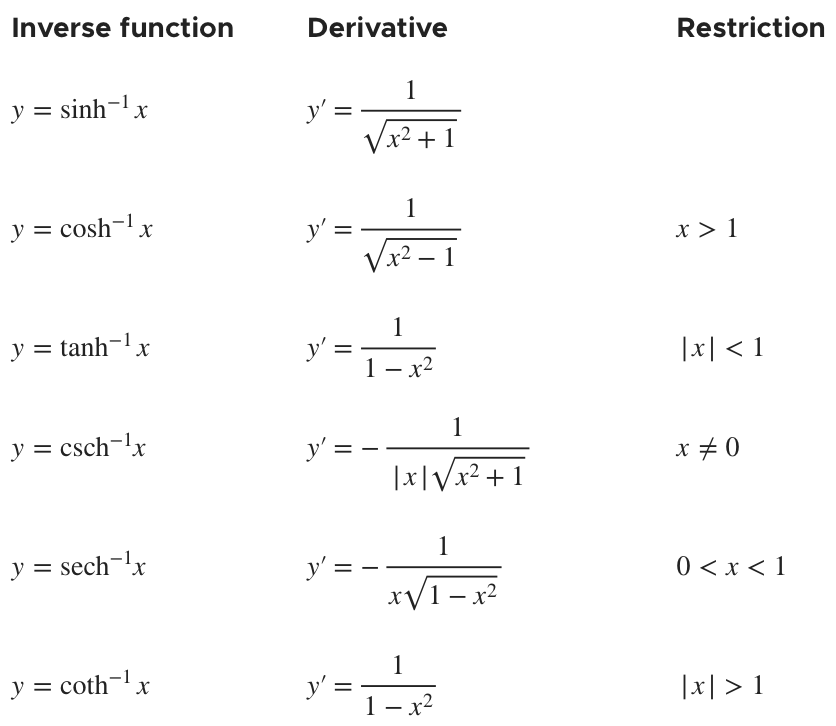Derivatives of inverse hyperbolic functions
The six inverse hyperbolic derivatives
To build our inverse hyperbolic functions, we need to know how to find the inverse of a function in general, so let’s review.
To find the inverse of a function, we reverse the ???x??? and the ???y??? in the function.
So for ???y=\cosh{(x)}???, the inverse function would be ???x=\cosh{(y)}???.
Hi! I'm krista.
I create online courses to help you rock your math class. Read more.
We’d then solve this equation for ???y??? by taking inverse hyperbolic cosine of both sides.
???x=\cosh{(y)}???
???\cosh^{-1}{x}=\cosh^{-1}{\left[\cosh{(y)}\right]}???
???\cosh^{-1}{x}=y???
???y=\cosh^{-1}{x}???
Remember that you can also see this function written as ???y={\text{arccosh}}{(x)}???. These are both representations of the inverse hyperbolic cosine function, and they can be used interchangeably.
Now that we understand how to find an inverse hyperbolic function when we start with a hyperbolic function, let’s talk about how to find the derivative of the inverse hyperbolic function.
Below is a chart which shows the six inverse hyperbolic functions and their derivatives.
How to use implicit differentiation to find formulas for inverse hyperbolic derivatives
Take the course
Want to learn more about Calculus 1? I have a step-by-step course for that. :)
Differentiating inverse hyperbolic cotangent
Let’s try an example with an inverse hyperbolic function.
Example
Find the derivative.
???y=-8\coth^{-1}{\left(21x^3\right)}???
Remember, as the chart above illustrates, we have to apply chain rule whenever we take the derivative of an inverse hyperbolic function.
That means that we take the derivative of the outside function first (the inverse hyperbolic function), leaving the inside function alone, and then we multiply our result by the derivative of the inside function.
???y\prime=-8\left[\frac{1}{1-\left(21x^3\right)^2}\right]\left(63x^2\right)???
???y\prime=-\frac{504x^2}{1-441x^6}???
Now let’s try an example with an inverse hyperbolic function occurring as part of a larger equation.
These are both representations of the inverse hyperbolic cosine function, and they can be used interchangeably.
Example
Find the derivative.
???y=6x^{-4}-\cosh^{-1}{\left(4x^7\right)}???
Applying chain rule, we get
???y\prime=-24x^{-5}-\left[\frac{1}{\sqrt{(4x^7)^2-1}}\right]\left(28x^6\right)???
???y\prime=-\frac{24}{x^5}-\frac{28x^6}{\sqrt{16x^{14}-1}}???
Let’s try one more example that’s a little more complex.
Example
Find the derivative.
???y={\text{sech}^{-1}}{\left(81x^4\right)}-5x^{-9}\sinh^{-1}{\left(6x^7\right)}+103x^8???
Taking the derivative one term at a time, applying product rule to the second term, ???-5x^{-9}\sinh^{-1}{\left(6x^7\right)}???, and remembering to apply chain rule, the derivative is
???y\prime=\left(-\frac{1}{81x^4\sqrt{1-\left(81x^4\right)^2}}\right)\left(324x^3\right)???
???-\left[\left(-45x^{-10}\right)\left(\sinh^{-1}{\left(6x^7\right)}\right)+\left(5x^{-9}\right)\left(\frac{1}{\sqrt{\left(6x^7\right)^2+1}}\right)\left(42x^6\right)\right]+824x^7???
???y\prime=-\frac{324x^3}{81x^4\sqrt{1-\left(81x^4\right)^2}}-\left[-45x^{-10}\sinh^{-1}{\left(6x^7\right)}+\frac{210x^{-9}x^6}{\sqrt{\left(6x^7\right)^2+1}}\right]+824x^7???
???y\prime=-\frac{324x^3}{81x^4\sqrt{1-\left(81x^4\right)^2}}+45x^{-10}\sinh^{-1}{\left(6x^7\right)}-\frac{210x^{-9}x^6}{\sqrt{\left(6x^7\right)^2+1}}+824x^7???
???y\prime=\frac{45\sinh^{-1}{\left(6x^7\right)}}{x^{10}}-\frac{4}{x\sqrt{1-6,561x^8}}-\frac{210}{x^3\sqrt{36x^{14}+1}}+824x^7???







